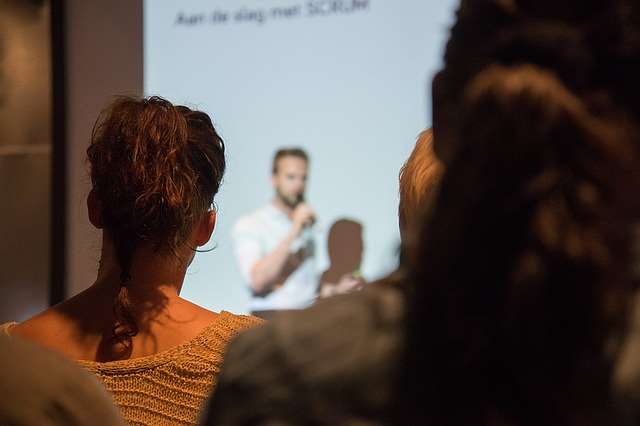Interview Presentation
All products and services featured are independently selected by WikiJob. When you register or purchase through links on this page, we may earn a commission.
- What Is the Employer Looking for in an Interview Presentation?
- How to Prepare for Your Interview Presentation
- What Makes a Great Interview Presentation?
empty
empty
- How to Deliver Your Interview Presentation
empty
empty
empty
empty
- Visual Aids for an Interview Presentation
- Tips for the Day of Your Interview Presentation
- Final Thoughts
Interview presentations are becoming a regular part of hiring practice. They are especially common for senior positions, or in industries that need strong communication skills.
An interview presentation is a short persuasive talk as part of an interview or assessment day. The employer will ask you to prepare a presentation on a specific topic in advance, or to present a blind presentation.
For a marketing position, you could be asked to market or sell a product, or to predict a market trend. Higher-level positions may require you to present a strategic outlook for the industry.
With blind presentations, a lot of the expectations are the same. The difference is that instead of preparing in advance, you will be given a topic on the day of the interview and will be given a limited time (maybe half an hour) to prepare.
In this situation, it is very important that you show the ability to think on your feet.
What Is the Employer Looking for in an Interview Presentation?
In every stage of the recruitment process, the employer is looking for a candidate who stands out.
They want an employee who knows their job and someone who will fit into the company culture.
Asking a candidate to give a presentation is another tool to help them assess whether that person is suitable for the role.
Interview presentations allow your employer to see the following key skills:
- Your communication style (verbal and written)
- Your ability to engage with your audience
- Your job and sector knowledge
- Your ability to follow a brief
- Your organisational skills
- Your attention to detail
For a blind presentation, the employer can also observe:
- How you perform under stress
- How creative you can be
Ultimately, the employer is also checking if you meet the core competencies in the job description, so be sure to revisit it during your preparation.
How to Prepare for Your Interview Presentation
How to Prepare for Your Interview Presentation
When you receive a phone call or email with information about your interview presentation, it is always a good idea to ask some or all of these key questions:
- Ask whether the presentation has a topic or if it is a blind presentation.
- Find out who your audience will be (and how many people you will be presenting to).
- Ensure you know how long the presentation should be.
- Ask whether you should prepare visual aids, and find out what IT equipment will be available.
During your presentation, you will be scrutinised by the interviewer, or by a panel of interviewers, and they will be judging your suitability for the role, based on what you talk about and how you present yourself.
It is therefore critical to be fully prepared, so that you can relax and do your best on the day.
Here is how to prepare for an interview presentation, step by step:
Step 1. Research
The first thing you should do is research the company. This includes checking its media presence, recent news articles and social media posts.
You should also research the application process for the organisation. For larger companies, there will be online forum discussions about interview presentations. You could even post your own questions to find out more.
Finally, research the assigned topic thoroughly and fact-check all your content. Make sure everything you say is your own work.
Step 2. Make Notes to Bring with You
If you are doing a blind presentation, you will likely be asked to present something about the industry or organisation. The best preparation is knowing plenty of information about the company and the latest industry news.
It is a good idea to put together some general notes, so that you can review these once you know the actual presentation topic.
On the day, you will have a set amount of time to prepare. This is usually less than thirty minutes, so accessible notes are key to performing well. Visual aids are not usually needed for a blind presentation.
Step 3. Practise Your Delivery
Practise your presentation in front of an audience to make sure you are speaking slowly, clearly and confidently. Also time yourself, so you know you won’t run over time on the day.
Ask your test audience to give you feedback on whether your argument was clear and easy to understand, and to ask you some questions at the end.

Step 4. Know Your Audience
The audience will be different depending on the position you are interviewing for.
Entry-level marketing or sales positions will most likely have members of the sales management team and someone from human resources. A higher-level position might have executives, company partners and board members.
If you have access to the names of people in your audience, it is always good to research their online presence. This will provide you with some guidance on their opinions, interests, knowledge level and status, and will be helpful when you are structuring your presentation.
For presentations with both technical and non-technical audience members, make sure your delivery interests both parties equally and is sufficiently easy to understand.
What Makes a Great Interview Presentation?
For a successful presentation:
- Give information to the audience in a clear, concise and confident manner.
- Keep things engaging with anecdotes and examples.
- Support your ideas with statistics and facts.
- Use short notes or bullet points on cue cards. Don't memorise and recite the entire presentation, or read from a prepared sheet.
- Anticipate and prepare for questions you might be asked after you finish.
Content
The content of your presentation should be straightforward and easy to understand; resist using too much industry jargon and avoid slang.
Don’t try too hard to seem funny or clever, as it will probably backfire. Keep things sharp, succinct and to the point.
Don't over-elaborate or waffle for the sake of using up time.
It is a good idea to use quotes to back up your points, especially if you will also be using slides. Be careful of plagiarism; have sources and copyright links for any third-party content and images you use.
And ensure you keep track of time. Giving an overly short presentation looks like a candidate is under-prepared. Giving a long presentation runs the risk of boring or agitating your assessors.
Structure
Your presentation should have a clear structure. Make sure the beginning and end are strong, as that is when the audience will pay the most attention.
Here are some tips on the best way to structure your presentation:
-
Introduction – Make sure you begin with a confident and friendly welcome. Introduce yourself and give a quick overview of the topic you have been asked to discuss and your expected goals. It is a good idea to mention that you will leave plenty of time for questions at the end; this will help to avoid any interruptions.
-
Sections or themes – Separate the different areas within your presentation into key points for a clearer and more memorable delivery. Back up your arguments with evidence.
-
Summary and conclusion – Summarise your arguments and provide recommendations. Reiterate the topic and address how your presentation has met the expected goal. Make sure you end by thanking the audience and inviting questions.
You could even use the STAR interview technique for your presentation.
- Situation – the issue or topic
- Task – what you hope to achieve or what the planned outcomes are
- Action – what you did, how you achieved it and the alternative options
- Results – outcomes, results and conclusion

How to Deliver Your Interview Presentation
The most important part of your presentation is how you present.
Interviewers are looking for candidates who are naturally professional. Someone who is confident, articulate and presentable.
Your delivery should be conversational but professional. The best way to practise this is to present to a trusted friend or relative, rehearse in the mirror or record yourself on camera.
When delivering your presentation, take note of the following:
Voice
Speak clearly and use a varied tone during your presentation. Don't speak too fast and be confident enough to pause often, especially between your key points.
Eyes
Maintain eye contact with your audience throughout your presentation. Look from person to person as you talk, to seem more relaxed and keep everyone engaged.
Smile
Be positive throughout your presentation. Smile when you begin, keep smiling as you talk and conclude with a smile.
Stance
When presenting, stand up straight with your shoulders back. Have open body language and use your hands to emphasise what you are saying, but not excessively.
Visual Aids for an Interview Presentation
If you have been asked to pre-prepare your presentation, it is worth asking if you can present with visual aids.
Visual aids can help to keep your presentation on track, highlight key information and provide interest for your audience.
They are usually slides (PowerPoint, Prezi) or a poster. Some content-heavy presentations may need a handout, but this is rarely the case for an interview.
Here are some top tips for great visual aids:
-
Make sure your slides aren’t too text-heavy or cluttered. Give the headlines just enough information to grab their attention, but not detract from the message you are trying to deliver.
-
Use clear and professional fonts that can be read easily from a distance.
-
Use different communication formats such as graphs, video clips and professional images, but don’t go overboard. Avoid busy themes or animations, especially swirly slide transitions.
-
Use quotes and references from industry leaders or related research. However, make sure you provide references for anything you use that belongs to a third-party source.
-
Incorporate a few company colours or themes for brand awareness (but keep the main background colour of your slides white). Check out the company website for its communication style and company branding; try to match your visuals to that style.
-
Make sure all visuals are proofread and double-checked by someone else as well. The last thing you want is a glaring typo on the wall behind you.
Tips for the Day of Your Interview Presentation
- Dress comfortably but professionally. Dress like you belong in the organisation.
- Have your material organised and ensure that it is easily accessible.
- Have multiple copies of your presentation with you. If you are bringing a laptop or digital content, bring a few backups on USB sticks or email your slides to yourself, just in case.
- Get to your interview a little before your allocated time, especially if you need to set up your laptop before you start.
- If you need to share presentation slides or other visual aids, have them ready to go and check that everything works before you start.
- If it is a blind presentation, read the assigned topic a few times and then spend a few moments organising your thoughts. Use your notes for your presentation structure.
- Before you start, take a deep breath and remember – Voice. Eyes. Smile. Stance.
- Be sure to breathe, pace yourself and speak clearly (we tend to speed up when nervous).
- If you get nervous, take a moment and a sip of water before you continue.
- Answer questions in a measured manner; defend your opinion but avoid arguments.
- After you finish, thank everyone for listening.
Final Thoughts
Key takeaways for a good presentation are research; following the instructions you are given; writing a well structured and concise presentation; and, above all, presenting confidently and with a smile.
During your presentation, be open to discussion and answer questions professionally.
Remember, your audience is already interested in you: your CV stood out and they want you to do well. Use your interview presentation as an opportunity to show them why you should be hired.

